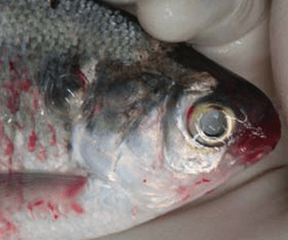Henneguya zschokkei
Henneguya zschokkei, also known as Henneguya salminicola,[2][3] milky flesh or tapioca disease,[1] is a species of a myxosporean parasite of certain species of salmon of genus Oncorhynchus.
| Henneguya zschokkei | |
|---|---|
 | |
| Henneguya zschokkei in salmon | |
| Scientific classification | |
| Kingdom: | Animalia |
| Phylum: | Cnidaria |
| Class: | Myxosporea |
| Order: | Bivalvulida |
| Family: | Myxobolidae |
| Genus: | Henneguya |
| Species: | H. zschokkei |
| Binomial name | |
| Henneguya zschokkei (Gurley, 1894) | |
| Synonyms[1] | |
| |
Henneguya salminicola is the first and thus far only known multicellular animal that completely lacks a mitochondrial genome and typical mitochondria, meaning it does not use aerobic respiration to produce energy, but some other, yet unknown, way.[4] Thus it does not breathe oxygen.[5]
Description
The Henneguya salminicola parasite is found in fish as an ovoid spore with two anterior polar capsules and two long caudal appendages.[6]
Hosts
Known hosts of Henneguya zschokkei include:[7]
- Oncorhynchus gorbuscha (Pink salmon)
- Oncorhynchus keta (Chum salmon)
- Oncorhynchus kisutch (Coho salmon)
- Oncorhynchus nerka (Sockeye salmon)
- Anadromous forms of Oncorhynchus mykiss (Rainbow trout)
- Oncorhynchus tshawytscha (Chinook salmon)
- Salmo salar (Atlantic Salmon)
Lack of mitochondrial genome
The anaerobic nature of Henneguya zschokkei was accidentally discovered by scientists at Tel Aviv University, who published their results in February 2020.[4] Professor Dorothee Huchon and colleagues noticed that this animal was missing a mitochondrial genome.[8][9][10]
See also
- Taxa
- Cryptosporidium parvum, a protist without organelle genes
- Mastigamoeba, an anaerobic protist without mitochondria
- Monocercomonoides, a protist without mitochondria
- Structures
- Hydrogenosome, an organelle of some anaerobic taxa
References
- "Henneguya salminicola". fishpathogens.net. Oregon State University. Oregon Department of Fish and Wildlife. Retrieved 2020-02-28.
- Ward, Henry B. (1919). "Notes on North American Myxosporidia". The Journal of Parasitology. 6 (2): 49–64. doi:10.2307/3270895. ISSN 0022-3395. JSTOR 3270895.
- Greenwood, Veronique (28 February 2020). "This Parasite Doesn't Need Oxygen to Survive - But that's not the weirdest thing about this jellyfish cousin that turns up in the muscles of salmon". The New York Times. Retrieved 5 March 2020.
- Yahalomi, Dayana; Atkinson, Stephen D.; Neuhof, Moran; Chang, E. Sally; Philippe, Hervé; Cartwright, Paulyn; Bartholomew, Jerri L.; Huchon, Dorothée (2020-02-19). "A cnidarian parasite of salmon (Myxozoa: Henneguya) lacks a mitochondrial genome". Proceedings of the National Academy of Sciences: 201909907. doi:10.1073/pnas.1909907117. ISSN 0027-8424. PMID 32094163.
- Brandon Specktor (24 February 2020). "Scientists discover first known animal that doesn't breathe". Live Science.
- Meyers, T. R.; Burton, T.; Bentz, C.; Starkey, N.; (July 2008). Common diseases of wild and cultured fishes in Alaska (PDF). Fish Pathology Laboratories. Alaska Department of Fish and Game. Yukon River Drainage Fisheries Association.CS1 maint: extra punctuation (link) CS1 maint: uses authors parameter (link)
- Buchtová, H.; Dyková, I.; Vršková, D.; Krkoška, L.; (2004). "Záchyt lososa masivně infikovaného myxosporidií Henneguya zschokke" [Myxosporidia Henneguya zschokkei massive infection in a salmon]. Veterinářství (in Czech) (54): 47–48. Archived from the original on 2007-09-28.CS1 maint: extra punctuation (link) CS1 maint: uses authors parameter (link)
- Andrew, Scottie (26 February 2020). "Scientists discovered the first animal that doesn't need oxygen to live. It's changing the definition of what an animal can be". CNN. Retrieved 2020-02-28.
- Shah, Gunjan (27 February 2020). "Scientists discover Henneguya salminicola, a life form that lives without oxygen". Republic World. India: Republic. Retrieved 2020-02-28.
- "Unique non-oxygen breathing animal discovered: The tiny relative of the jellyfish is parasitic and dwells in salmon tissue". ScienceDaily. 25 February 2020. Retrieved 2020-02-28.
Further reading
- Lebbad, M.; Willcox, M. (Jun 1998). "Spores of Henneguya salminicola in human stool specimens". J Clin Microbiol. 36 (6): 1820. doi:10.1128/JCM.36.6.1820-1820.1998. PMC 104934. PMID 9620434.
External links
- "Henneguya zschokkei (Knutsjuka)". sva.se (in Swedish). Statens Veterinärmedicinska Anstalt. 28 October 2005. Archived from the original on 7 October 2006.
